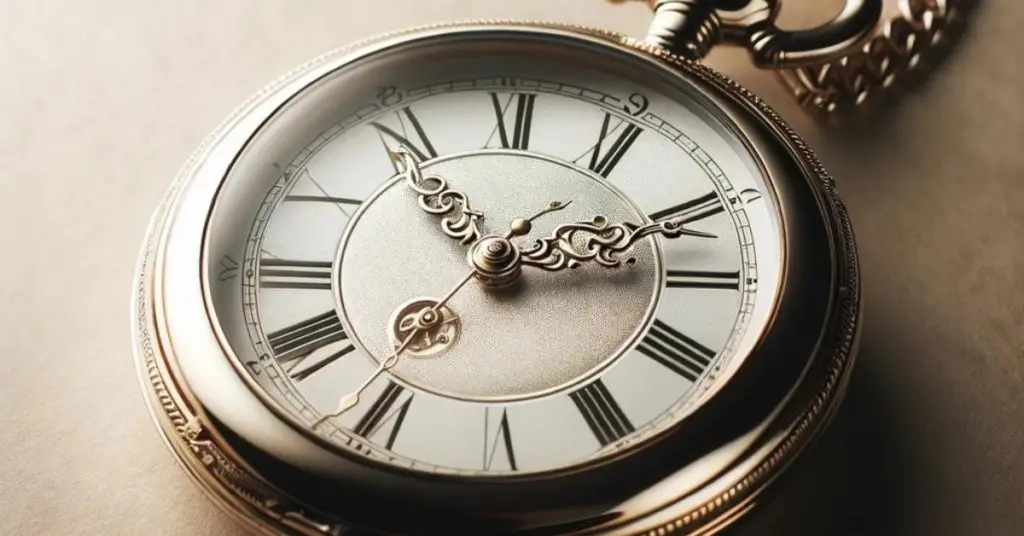Opening a pocket watch to check the time is a unique experience that blends tradition with the simple pleasure of observing a timepiece. We often find ourselves fascinated by the intricate craftsmanship of pocket watches, especially when they carry the rich history of vintage or antique designs. These small, portable treasures hold more than just the time; they encapsulate moments of the past in their delicate gears and polished cases. But often we found ourselves with the question: “How to Open a Pocket Watch to See the Time?”. Let’s answer this question together!
Identifying Your Pocket Watch Type

Before we dive into the specifics, it’s essential we correctly identify your pocket watch type. This will determine the proper method for opening it to tell the time.
Recognizing Hunter-Cased Watches
Hunter-cased watches are distinctive by their protective outer shell, which typically features a spring-hinged cover. Upon pressing the crown or a lever, you can expect the cover to spring open, revealing the watch face. These cases can include both full hunter watches, with a solid cover, and half hunter watches sporting a cover with a small window to view the time without fully opening it.
Distinguishing Open-Face Watches
Unlike their hunter-cased counterparts, open-face watches lack a front cover, which means the watch face and hands are immediately visible. Many open-face watches are lever-set, requiring you to pull out a lever on the side of the watch to adjust the time. Some might be side-winders, where the winding stem is positioned at 3 o’clock, as opposed to the traditional 12 o’clock.
Understanding Swing-Out Cases
With swing-out cases, you won’t find a seam like you would in a snap-off or screw-off case back; these cases are designed for the movement to swing out from the front after removing the front bezel. Be sure to pull out the winding stem before attempting to lift the movement out to ensure the utmost care for your watch’s delicate mechanics.
Opening the Pocket Watch
We’re going to get right into the heart of pocket watch craftsmanship by showing you how to reveal the elegant dial hiding within. Whether your watch has a crown and stem, a screw-off case, or a hunter-style cover, we’ve got you covered.
Using the Crown and Stem
To open a pocket watch with a crown and stem, we hold the watch steady and gently pull the crown. This action releases the latch allowing us to access the time inside. Remember, winding the watch is different—wind the winding knob at the 12:00 position without pulling it to keep the watch ticking.
Operating Screw-Off and Snap-Off Cases
For screw-off cases, we need to grasp the case by the edges and twist. It’s essential to apply even pressure and look for alignment marks to avoid cross-threading. With snap-off cases, a specialized tool, like a case knife or just a pocket knife, comes in handy. We carefully insert the blade into the seam-line and gently pry it open, being careful not to damage the delicate parts inside.
Handling Hunter-Style Cases
Hunter-style watches are a bit different—they have a hinged cover protecting the watch face. We’ll need to locate the latch, often at the 3:00 or 6:00 position, and press it to swing open the cover. Some hunter cases could also feature a lever at the 9:00 position that we’ll press to pop open the front bezel, revealing the watch’s face.
Caring for Your Pocket Watch

Here, we’ll dive into the best practices for keeping your timepiece in pristine condition.
Regular Maintenance Tips
- Regular Cleaning: To maintain the accuracy and appearance of your pocket watch, it’s essential to clean it regularly. Use a soft, lint-free cloth to gently wipe the glass or crystal to remove fingerprints and smudges.
- Check for Dust and Moisture: Dust can clog the mechanism, while moisture can cause corrosion. Ensure that the back of the case is sealed properly to minimize the risk of dust and moisture intrusion.
Avoiding Common Damages
- Handle with Care: Antique pocket watches, especially those that are gold-filled or rare, should be handled with extra caution to avoid scratches. When you store your watch, ensure that it is kept in a clean, dry place with adequate clearance away from other objects.
- Protect the Watch Face: To prevent damage to the watch face, always carry your pocket watch with the dial facing inwards. This helps protect the crystal from potential impacts.
Seeking Professional Assistance
- Visit a Professional Watchmaker: For deeper cleaning and maintenance, bring your pocket watch to a professional watchmaker. They have the specialized tools and knowledge required to provide proper watch repair and servicing.
- Regular Servicing: We recommend a professional service every few years to maintain your watch’s performance and condition. This is particularly important for antique pocket watches, as they may need more specialized care.
Understanding the Mechanics
To truly appreciate the intricacies of a pocket watch, we need to delve into its mechanics. By exploring the movement and mastering the winding and setting process, we ensure our timepieces not only open but function impeccably.
Exploring the Movement
The movement governs the watch’s operation, acting as an intricate symphony of gears and springs. The gear train, orchestrated by the escapement, governs the release of energy in precise increments. This meticulous sequence is all held together within the movement, typically visible once you open the back cover or cuvette of the pocket watch. Our first goal is to uncover this artistry, typically shielded by the outer case back.
In a hinged case back design, look for a groove along the outer case. This indentation is where we will gently use a tool, like our fingernail or a watchmaker’s knife, to pry open the watch, revealing the movement within. It’s crucial to do this with care to prevent damage to the watch’s working components.
Winding and Setting Time
The art of winding and setting the time is essential to keep our pocket watches ticking. For winding, we typically turn the crown clockwise. It’s the small handle connected to the winding arbor, fulfilling dual functions for both winding and time setting. Here’s how we handle this:
- Winding: Hold the pocket watch securely. Turn the crown clockwise until we feel slight resistance, signaling the watch is fully wound.
- Setting Time: If the watch has a pull-out crown, gently pull it out to engage the setting mechanism. We then turn the crown carefully to set the time.
Always be gentle when closing the outer case back or cuvette to avoid disrupting the movement. By following these precise actions, we ensure our pocket watches are wound correctly and display the perfect time, every time.
FAQ-How to Open a Pocket Watch to See the Time
What are the common types of pocket watch cases, and how do they open?
Pocket watches typically come in three main types of cases: hunter-case, open-face, and half-hunter. Hunter-case watches have a spring-hinged cover that protects the crystal and dial, which you open by pressing down on the crown. Open-face watches have no cover over the crystal, so you can see the time directly. Half-hunter cases feature a lid with a glass window or hole, allowing time to be read without opening the watch fully.
How do I safely open a hunter-case pocket watch?
To safely open a hunter-case pocket watch, hold the watch in one hand and locate the small notch on the case rim or the crown. Gently press down on the crown or use your fingernail to pry open the front cover from the notch. It’s important to open the cover gently to avoid damaging the hinge or the watch mechanism.
Are there any special precautions I should take when opening an antique pocket watch?
Yes, when opening an antique pocket watch, it is crucial to handle it with care to avoid damaging delicate components. Always ensure your hands are clean and dry to prevent oils and moisture from affecting the metal and internal parts. If the watch seems resistant to opening, do not force it; instead, seek the assistance of a professional watchmaker to prevent damage. Additionally, using soft gloves can help protect the watch’s finish and reduce the risk of scratches.
If you liked this blog post about the topic: How to Open a Pocket Watch to See the Time, don’t forget to leave us a comment down below to tell us about your experience with it.


